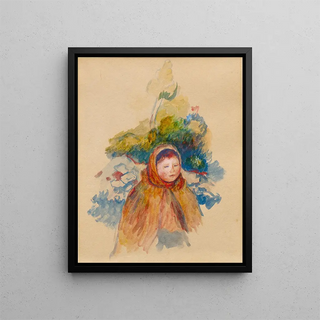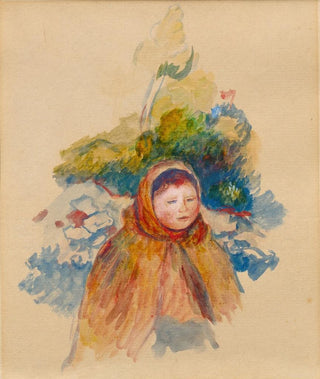Art print | Young Peasant Woman - Pierre-Auguste Renoir


View from behind

Frame (optional)
In the enchanting world of Impressionism, the art print "Jeune paysanne" by Pierre-Auguste Renoir stands out for its delicacy and authenticity. Painted in 1880, this canvas evokes the simplicity and beauty of rural life, while capturing the very essence of youth. The sparkling gaze of the young peasant girl, her barely sketched smile, and her natural posture invite the viewer to immerse themselves in a moment of grace and serenity. Renoir, master of colors and lights, manages to transform an ordinary scene into a poetic representation, where every detail, from the drape of the dress to the softness of the features, contributes to a striking visual harmony.
Style and uniqueness of the work
Renoir's style, characterized by fluid brushstrokes and vibrant palettes, is fully revealed in "Jeune paysanne". The artist uses warm and luminous colors, creating a joyful and lively atmosphere. The composition is carefully balanced, highlighting the central figure of the peasant girl while subtly integrating the surrounding landscape. The play of light, typical of Impressionism, emphasizes the texture of the skin and the reflections on the dress, offering a sense of depth and movement. This art print is a perfect example of Renoir's ability to transcend realism to achieve a form of idealization, where the beauty of everyday life is celebrated with infinite tenderness.
The artist and his influence
Pierre-Auguste Renoir, an emblematic figure of the Impressionist movement, left a lasting mark on his era with an innovative vision of painting. Born in 1841, he was initially influenced by artists such as Claude Monet and Édouard Manet, but quickly developed his own style, blending sensitivity and technique. Renoir explored various themes, from scenes of Parisian life to intimate portraits, but he excelled in depicting women and nature. His influence extends far beyond his time, inspiring many contemporary and future artists. Through his works, he helped redefine the aesthetic codes of his era, laying the foundations for a new

Matte finish

View from behind

Frame (optional)
In the enchanting world of Impressionism, the art print "Jeune paysanne" by Pierre-Auguste Renoir stands out for its delicacy and authenticity. Painted in 1880, this canvas evokes the simplicity and beauty of rural life, while capturing the very essence of youth. The sparkling gaze of the young peasant girl, her barely sketched smile, and her natural posture invite the viewer to immerse themselves in a moment of grace and serenity. Renoir, master of colors and lights, manages to transform an ordinary scene into a poetic representation, where every detail, from the drape of the dress to the softness of the features, contributes to a striking visual harmony.
Style and uniqueness of the work
Renoir's style, characterized by fluid brushstrokes and vibrant palettes, is fully revealed in "Jeune paysanne". The artist uses warm and luminous colors, creating a joyful and lively atmosphere. The composition is carefully balanced, highlighting the central figure of the peasant girl while subtly integrating the surrounding landscape. The play of light, typical of Impressionism, emphasizes the texture of the skin and the reflections on the dress, offering a sense of depth and movement. This art print is a perfect example of Renoir's ability to transcend realism to achieve a form of idealization, where the beauty of everyday life is celebrated with infinite tenderness.
The artist and his influence
Pierre-Auguste Renoir, an emblematic figure of the Impressionist movement, left a lasting mark on his era with an innovative vision of painting. Born in 1841, he was initially influenced by artists such as Claude Monet and Édouard Manet, but quickly developed his own style, blending sensitivity and technique. Renoir explored various themes, from scenes of Parisian life to intimate portraits, but he excelled in depicting women and nature. His influence extends far beyond his time, inspiring many contemporary and future artists. Through his works, he helped redefine the aesthetic codes of his era, laying the foundations for a new






